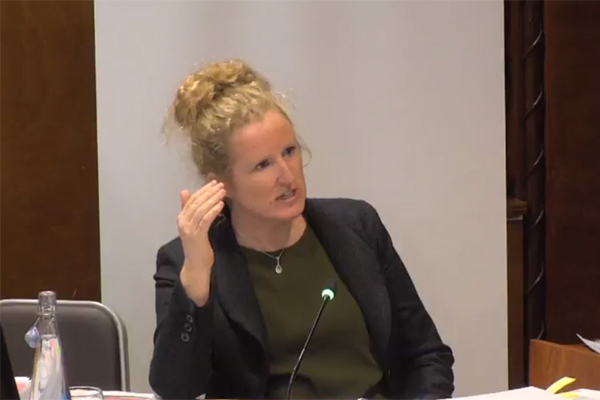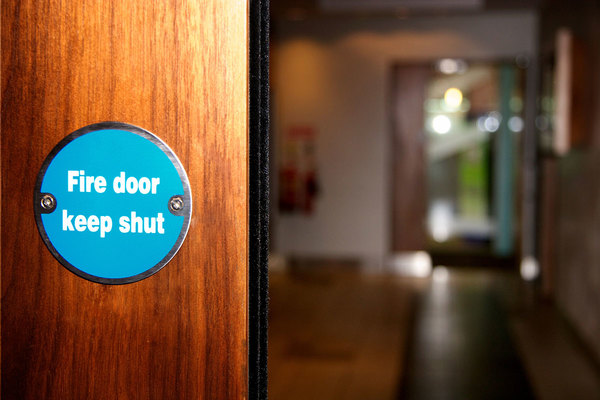You are viewing 1 of your 1 free articles
Grenfell Inquiry day 80: fire doors in tower differed from those tested by manufacturer
Further evidence about poor-quality fire doors and failures of compartmentation was raised at today’s Grenfell Inquiry in central London.
Dr Barbara Lane, who has produced a lengthy expert report for the inquiry and gave evidence last week, appeared before the inquiry again today to address further evidence points.
She began with a discussion of the fire doors in the tower – telling the inquiry that 106 of the 120 doors in the tower were replaced with a ‘Masterdor Suredor’ made by Manse Masterdor in a replacement programme that began in 2011.
These new fire doors have already been the subject of serious scrutiny, with many residents having also reported to the inquiry that their ‘self-closers’ were either missing or broken, meaning many were left open on the night of the blaze causing toxic smoke to pour into the lobbies and stairwells.
The police also revealed in March that they did not meet the legal minimum standard of 30 minutes’ fire resistance – despite having been tested to this standard before being sold.
Dr Lane told the inquiry today that the doors installed in Grenfell Tower differed from the product tested by the manufacturer before sale in several key ways.
She said the ‘hardware’ (such as locks and letter boxes) was different from the tested door.
“If you want to use the phrase ‘getting the door through the test’ it [the hardware] is a sensitive business. Any piece of metal, locks, letter boxes may act as heat spread route, flame spread route, hot smoke route and cause the door to fail,” she said.
She also said the door was tested on one side only, in contravention of guidance for composite doors. The glazing tested was also a different specification from that installed.
The doors were also never tested to the relevant ‘smoke’ standard – which requires cold smoke testing to check the doors for leakage. This standard is known as FD30S (Fire Door 30 minutes, smoke) as opposed to FD30, which does not have a smoke pass. “I don’t understand why an FD30 door was installed when an FD30S door should have been. S was not ordered and S was not delivered,” she said.
She added that guidance has been clear on the importance of self-closers since the 1970s, and that most best practice guidance suggests they should be checked for performance every six months.
“The guidance since the ’70s has been very clear about why it is so important,” she said.
Inside Housing analysis of survivors’ statements suggests self-closers were missing or broken in 56% of the flats in the tower.
Dr Lane also discussed the installation of gas pipes in the tower, which she said may have breached ‘compartmentation’ between the lobbies. This is the design feature which contains smoke within a certain space in the tower. The newly installed gas pipes in the lobbies were due to be ‘boxed-in’ but had not been by the time the fire happened.
She said she did not know if there was any interim fire-stopping material in place until this work was carried out, but added: “What it does affect is that [it] acts as a link from lobby to lobby. If the next pipe run if the same hole is there, it could act as a smoke run from lobby to lobby.”
She also explained that the lifts in Grenfell Tower did not have a ‘firefighting’ function, which requires an alternative power source and additional fire protection to allow their use during a blaze. She said this may have made the building non-compliant with a functional requirement of building regulations that all residents – including those with mobility issues – are able to escape.
Asked if the lift should have been taken out of service on the night of the fire, Dr Lane said: “Frankly, if I may say so, it shouldn’t have been provided in that condition in the first place and that should have been known.”
The inquiry continues.
The Grenfell Tower Inquiry
Closing statements
Day 85: victims' lawyers attack the fire brigade
Further expert evidence
Including some additional evidence from emergency call handlers, bereaved and relatives
Day 84: further evidence from survivors and relatives
Day 83: swift evacuation of tower possible if residents alerted
Day 82: initial fire was extinguished but then returned to the flat
Day 81: overheating fridge-freezer most likely cause of fire
Day 80: fire doors installed did not match product tested
Day 79: resident advised to stay put despite fire in flat
Day 78: insulation and cladding material below required standard
Day 77: molten plastic spread blaze down tower
Day 76: 'stay put' should be dropped when fire spreads across floors
Other witness evidence
Police, ambulance, gas suppliers, council, TMO and call room operators give evidence
Day 75: call room operators give evidence
Day 74: further evidence from TMO officers
Day 73: TMO boss failed to pass information to firefighters
Day 72: fire finally extinguished when gas switched off
Day 71: further questions over stay put advice
Day 70: the police evidence
The bereaved, survivors and relatives’ evidence
Day 69: video shows smoke billowing through fire door
Day 68: KCTMO removed self closing mechanism and never replaced it
Day 67: gaps in cladding fixed with duct tape
Day 66: 'don't fix broken system with a sticking plaster'
Day 65: survivor dragged disabled man down nine floors to safety
Day 64: KCTMO 'did not replace broken fire door'
Day 63: foam insulation inside cladding 'exposed' says survivor
Day 62: father gives harrowing account of son's death
Day 61: council’s management organisation slammed for faulty electrics
Day 60: stay put advice ‘led to deaths’, residents say
Day 59: residents describe problems with new windows
Day 58: survivor describes how daughter saved his life
Day 57: firefighter evidence ‘a slap in the face’, says survivor
Day 56: relations with contractor were ‘toxic’
Day 55: resident 'never happy' with stay-put advice
Day 54: tenant gives evidence about housing association
Day 53: stay put advice 'felt like trap'
Day 52: resident saved by son's phone call
The firefighters’ evidence
Day 51: firefighter feared encouraging residents to jump
Day 50: the LFB commissioner
Day 49: fire chief reveals frustration over lack of building plans
Day 48: internal fire spread 'bigger story' than cladding
Day 47: fire officer considered evacuating crews over building collapse fears
Day 46: 'we were improvising' senior firefighter admits
Day 45: firefighter urged for abandonment of 'stay put' policy
Day 44: firefighter recalls radio signal difficulties
Day 43: call hander 'uncomfortable' with insisting residents stay put
Day 42: residents only told to leave if they called fire brigade back
Day 41: breathing equipment delay 'hampered rescues on upper floors'
Day 40: chiefs told firefighters to abandon policy
Day 39: firefighters reveal dramatic rescue of children
Day 38: firefighters issue aplogies to families
Day 37: council 'unable to provide tower plans'
Day 36: QC defends inquiry process
Day 35: Javid would welcome interim recommendations
Day 34: water from hose 'too weak' to reach the flames
Day 33: 'oh my god, we've been telling people to stay put'
Day 32: further fire fighter describes lack of equipment and low water pressure
Day 31: 'incredibly difficult' task of recording information outlined
Day 30: struggle to maintain control over rescue operation described
Day 29: fire service 'overwhelmed' by survival guidance calls
Day 28: 'the building beat us'
Day 27: firefighters 'forced to abandon plans to reach roof'
Day 26: poor signage hindered rescue efforts
Day 25: water pressure left firefighting equipment 'like garden hose'
Day 24: decision to abandon 'stay put' explored
Day 23: TV images 'could have assissted' rescue effort
Day 22: description of hectic scenes in the control centre
Day 21: account from the fire service 'nerve centre'
Day 20: firefighter describes 'huge volume' of calls from trapped residents
Day 19: firefighter 'given no training on cladding fires'
Day 18: evacuation would have been 'huge catastrophe'
Day 17: firefighters describe access and lift issues
Day 16: scenes of carnage likened to 9/11
Day 15: firefighters recount trauma of survival guidance calls
Day 14: firefighters describe spread of blaze
Day 13: firefighters recall radio difficulties
Day 12: "it was like a war zone"
Day 11: questions raised over fire fighters' radios
Day 10: watch manager emotional under questioning
Day nine: lead firefighter 'not trained in stay put policy'
The expert reports: authors give evidence to inquiry
Day eight: where the fire started
Day seven: what was in the cladding?
Day six: the cause and spread of the fire
Day five: expert highlights key issues
Day four: firefighters defend response to fire
Day three: council and contractors appear for the first time
Day two: lawyers for the survivors make their case
Day one: expert evidence released on cladding and stay put
The commemoration hearings
30 May: Grenfell Council 'recognised it should not house disabled victim above four storeys'
29 May: Anger on day six of the Grenfell Inquiry
25 May: Grenfell families 'forced to live in chimney with stay put policy'
24 May: Grenfell family complained about father being housed on 17th floor
23 May: Tributes to children on third day of Grenfell hearings
22 May: Emotions run high as Grenfell bereaved shown footage of the tower burning
21 May: Grenfell victims share tributes as inquiry opens











